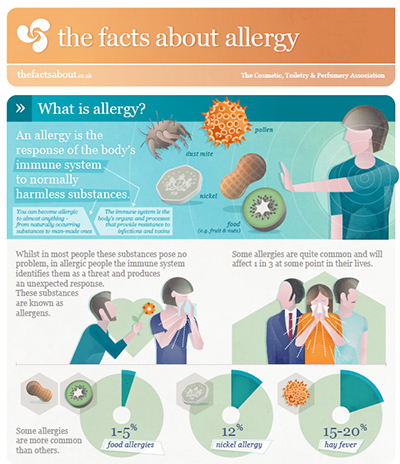CTPA has produced a factsheet and a consumer guide about allergies and the procedure for an allergy alert test.
Using the selections below, you can click to a section of this article to find the information most relevant to you:
- What is an allergy?
- How does allergy work?
- Can cosmetics cause allergies?
- Why are ingredients known to cause allergies used in cosmetics?
- Preservatives
- Hair dyes
- Fragrance (Parfum)
- Artificial nail systems
- Ingredient labelling
- Ingredient labelling - Chemical names and corresponding INCI names
- What does 'hypoallergenic' mean?
- What should I do if I have an allergic reaction?
What is an allergy?
'Allergy' is a term that is often misused to describe all kinds of adverse reactions. There are two main types of adverse reactions that may be experienced: irritant reactions and allergic reactions. In fact there's a big difference between being irritated by a substance and being allergic to it.
Irritant reactions are the most common adverse reaction and should not be confused with allergic reactions. An irritant type of reaction occurs rapidly following use of a product. Redness of the skin, sometimes with an itch, is characteristic of an irritant effect. This clears up rapidly after ceasing to use the product that is causing the problem.
Allergic reactions are excessive reactions by our bodies to substances in our environment that are harmless to the majority. Unlike irritant reactions, allergic reactions involve the body's immune system. A person who is allergic to a substance may be sensitised to it for the rest of their life yet most people would never become allergic to that same substance. Everyone is different - what you will become allergic to is determined by your genes. Some people may never develop an allergy.
To find out more about allergy and how it works, click on the link or image below to look at the full infographic:
How does allergy work?
There are two main types of allergy: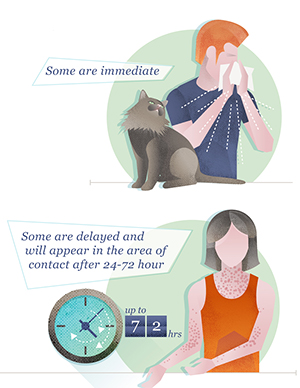
-
Immediate: an allergic reaction that occurs suddenly, generally a few minutes after exposure to the allergen. Common examples are hay fever triggered by pollen or allergic asthma triggered by animal hair.
-
Delayed: an allergic reaction that does not show until some time, usually 24 to 72 hours, after contact with the allergen. An example is 'allergic delayed contact dermatitis' triggered by skin contact with the allergen and producing a local reaction at or near the area of contact. If further contact with the allergen is avoided, there will be no further reaction and the skin heals.
Can cosmetics cause allergies?
"People can even be allergic to commonly used products. It's not that ingredients in these are unsafe - it's the way the body reacts to them can differ from person to person."
Dr Chris Flower, Chartered Biologist & Toxicologist
Almost any substance, natural or man-made, has the potential to produce an allergic reaction in someone, somewhere; the body does not differentiate whether something is natural or synthetic - it is the properties of the substance itself and not its origin that is key. As with some foods, you may not know you are sensitive to a cosmetic ingredient until you try out a product and have an adverse reaction. However, where a higher risk of allergy has been identified, such as with some hair dyes, the product will always carry a warning label and users will be advised to carry out an allergy alert test before applying the product in full.
Cosmetic products are subject to strict UK safety rules to ensure that they don't pose a health risk. Safety assessments include allergy safety, which greatly minimises the risk of products causing adverse reactions.
"The process of determining the safety and composition of a product is rigorous and great care is taken to constantly re-assess the science behind it. This means a team of scientists will be involved ensuring the latest scientific knowledge and safety evaluation techniques are used. It can take many years to bring a product to market."
Dr Emma Meredith, Director-General of CTPA and a Pharmacist
Why are ingredients known to cause allergies used in cosmetics?
Substances known to cause widespread allergic reactions are not used in cosmetics but each person is different and we might find we are allergic to substances that others use or consume without any problems. For example, many people eat peanuts and yet some cannot, and whilst pollen makes summer miserable for hay fever sufferers the majority have no such problems.
It is not possible to avoid all substances in cosmetics that might cause a rare allergic reaction in someone any more than we could avoid all foods to which someone might be allergic (such a list would include nuts, eggs, wheat and flour, and so all biscuits, cakes etc., shellfish, many fruits and many common vegetables).
It is important to always check the ingredients list of the cosmetic product you intend to buy or use to make sure it does not contain any ingredients to which you are allergic.
 Of all classes of cosmetic ingredients, preservatives are more likely to cause allergies than the rest. However, preservation is essential for cosmetic safety and quality, and avoiding preservatives completely is not possible.
Of all classes of cosmetic ingredients, preservatives are more likely to cause allergies than the rest. However, preservation is essential for cosmetic safety and quality, and avoiding preservatives completely is not possible.
There is a small pool of effective preservatives that are allowed to be used in cosmetics. They are needed to keep products bug-free, but unfortunately some people may be allergic to one or more of them. Only a few have the rare quality of being able to work across a variety of products in order to keep them safe and microorganism-free without changing the formulation which creates the look, feel and smell.
Watch a short video clip to see why preservatives are so important.
The European Commission infographic emphasises the importance of preservatives for cosmetic products.
Hair dyes Permanent and oxidative hair dyes are used because they are the best way to achieve permanent hair colour and the only way of colouring grey hair. The number of reactions to these hair dyes is very low and they are safe to use when instructions are followed, including an Allergy Alert Test.
Permanent and oxidative hair dyes are used because they are the best way to achieve permanent hair colour and the only way of colouring grey hair. The number of reactions to these hair dyes is very low and they are safe to use when instructions are followed, including an Allergy Alert Test.
One hair dye, para-phenylenediamine (PPD), is safely used in hair colorant products. However, you may see PPD being used (illegally) in so-called "black henna" temporary tattoos. If applied directly to the skin in a temporary tattoo, PPD can cause quite severe reactions. Consequently, this use of PPD is prohibited. Find out more about the illegal use of PPD and how to avoid it.
Fragrance (Parfum)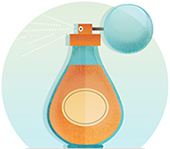 Although rare, reactions to fragrances sometimes occur. Consumers diagnosed as allergic to certain fragrance ingredients should avoid all fragrance, which is shown on the list of ingredients by the word "parfum", unless they have checked with the manufacturer of a particular fragrance whether or not the problem ingredient is present in the product. However, 26 fragrance ingredients known to cause a higher incidence of allergy will be listed individually to help consumers make an informed choice.
Although rare, reactions to fragrances sometimes occur. Consumers diagnosed as allergic to certain fragrance ingredients should avoid all fragrance, which is shown on the list of ingredients by the word "parfum", unless they have checked with the manufacturer of a particular fragrance whether or not the problem ingredient is present in the product. However, 26 fragrance ingredients known to cause a higher incidence of allergy will be listed individually to help consumers make an informed choice.
Find out more about fragrance allergies and fragrance-free cosmetic products.
Artifical Nail Systems
Many artificially enhanced nails contain ingredients that all come from a chemical family called 'acrylates'.
Dermatologists are seeing increasing numbers of patients in their clinics with dermatitis or inflammation of the skin linked to exposure to acrylates when using Liquid and Powder (L&P) and UV gel nail systems. The reactions are not always limited to the finger area around the nail itself but can arise wherever the nail contacts the skin, such as on the face for example. Dust generated from filing or removal of incompletely cured nail coating can also be associated with allergic reactions.
The cured or polymerised nail is unlikely to cause a problem but the liquid acrylate monomers in the starting material may, over time, if exposure to the skin is high enough, lead to allergy. The risk may be minimised by ensuring the liquid monomer or gel is not allowed to contact the skin itself, that the gel is cured fully by using the curing lamp correctly and that any uncured gel is removed completely and in such a way that the tissue or pad used does not contact the skin of either the customer or the nail professional. UV gel that is improperly cured can release the monomers when filed or removed.
The nail system should only be used with the corresponding LED or UV lamp which is specified by the manufacturer. If the incorrect lamp and nail system are used together, the nail system may not be fully cured, which can lead to more uncured methacrylate monomers remaining on the nail surface and a possible increased risk of allergy.
In the case of L&P acrylic nails, the liquid and powder system also needs to be matched and formulated to work together. It is the liquid that has the potential to cause allergy and contact with the skin needs to be avoided during the application. An unmatched system or one that is used improperly, as with UV gel, could allow the uncured product to be released onto the skin during filing or removal.
This is especially important for home use, to make sure the product is used and applied as intended and only on the nail bed.
Acrylates have a wide range of applications, including in certain medical and dental procedures. If an individual develops an allergy to methacrylate chemicals, through exposure to the chemicals in any of these applications, this can have implications for any future dental and medical procedures. Importantly, such allergies may be, and frequently are, lifelong.
If you have any concerns about your nails and how to care for them, do speak with your nail salon professional who will be able to advise you on how often you should have your artificial nails applied and how to keep your nails in best condition.
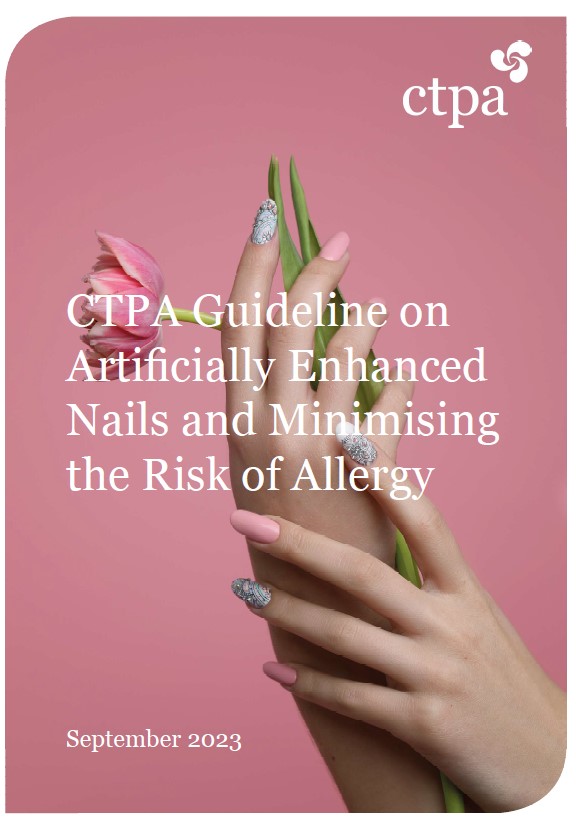 CTPA has created a "Guideline on Artificially Enhanced Nails and Minimising the Risk of Allergy", which has been developed for salon professionals, consumers, manufacturers and others with involvement in artificially enhanced nails. The Guideline explains that dermatologists are seeing an increase in the rates of allergic reaction to acrylate monomers in Liquid and Powder (L&P) and UV cured gel nail systems, and contains advice on how to minimise the risk of developing such an allergy.
CTPA has created a "Guideline on Artificially Enhanced Nails and Minimising the Risk of Allergy", which has been developed for salon professionals, consumers, manufacturers and others with involvement in artificially enhanced nails. The Guideline explains that dermatologists are seeing an increase in the rates of allergic reaction to acrylate monomers in Liquid and Powder (L&P) and UV cured gel nail systems, and contains advice on how to minimise the risk of developing such an allergy.
The Guideline contains advice for safe use of these products for both salon professionals and end users, highlighting the following key points:
-
Avoid skin contact
-
Apply to healthy nails only
-
Wear appropriate gloves
-
Do not reuse gloves
-
Remove gloves in a manner which avoids skin contact with the contaminated part of the gloves
-
Use the correctly-matched lamp and gel system
-
Use reputable products which comply with cosmetics legislation
Ingredient labelling
All cosmetic products sold in the UK and Europe must display a complete ingredients list. In whatever European country you buy your cosmetic product, the ingredient names will be the same.
This helps users to identify products with ingredients to which they know they are sensitive. Ingredient names must, by law, comply with European requirements and use the International Nomenclature of Cosmetic Ingredients, known as INCI.
The CTPA has produced an ingredient labelling help note for dermatologists.
Ingredient labelling - Chemical names and corresponding INCI names
By law, all cosmetic products sold in the UK must display a complete ingredients list. Ingredient labelling helps users to identify products with ingredients to which they know they are allergic. Ingredient names must, by law, use the International Nomenclature of Cosmetic Ingredients, known as INCI. This means that whether you buy your cosmetic in UK or Europe, the ingredient names will be the same. These INCI names have also been adopted by many countries worldwide.
If you have been diagnosed with an allergy to a substance, you may have been given the substance's chemical name or common name. The tables on this page provide the corresponding INCI name for cosmetic ingredients which are more frequently associated with allergies or sensitisation.
Artificial nails and nail cosmetics
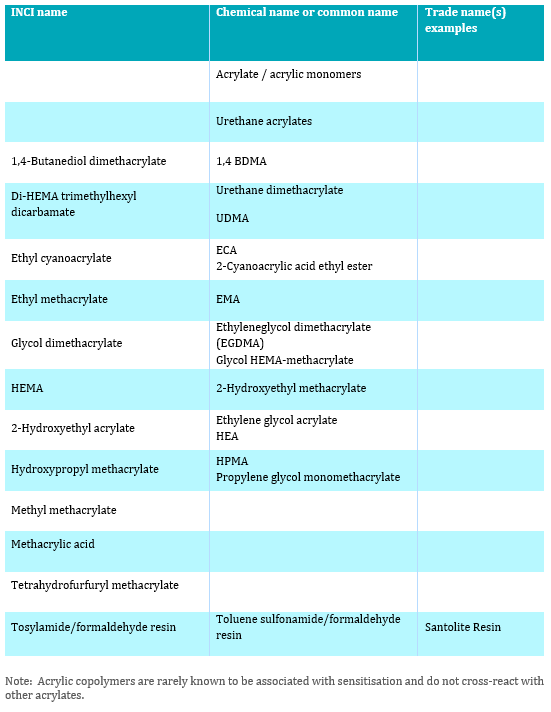
Hair colorants
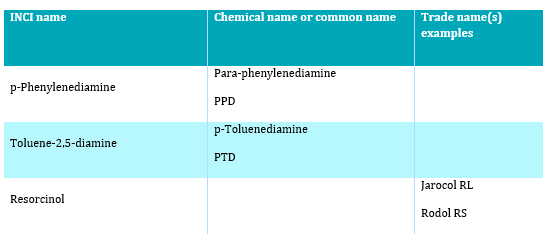
Preservatives
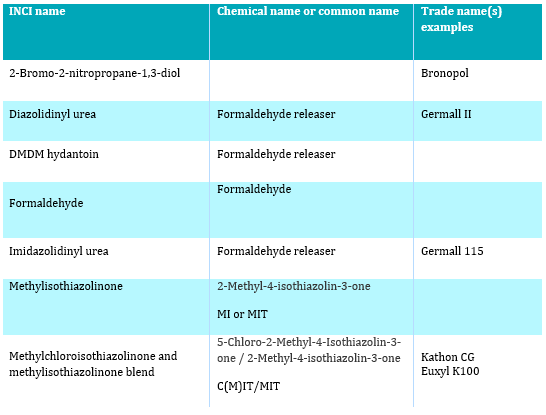
UV filters
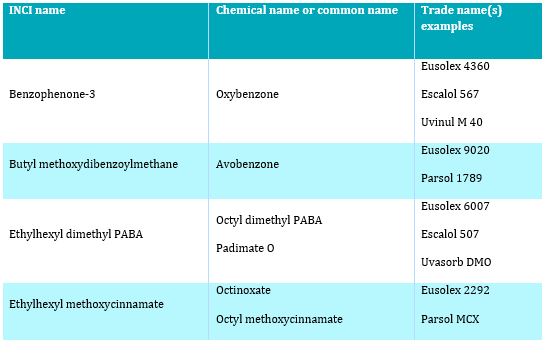
Other

Perfume/fragrance and fragrance allergens
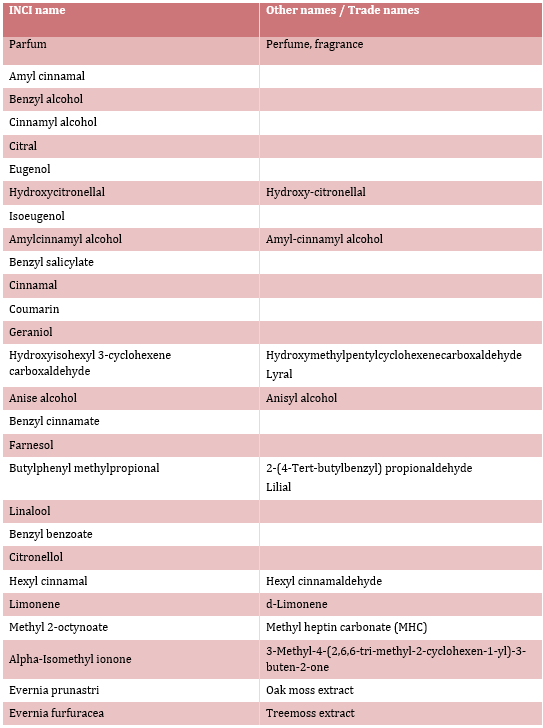
Nut allergies
Consumers with a known allergy to certain nuts may wish to avoid products that contain nut derived ingredients. Table 3 gives a list of common nuts and the INCI names by which they will be declared on the labels of cosmetic products.

What does 'hypoallergenic' mean?
'Hypo-' means 'less than' or 'decreased' so, when used to describe cosmetics, the term hypoallergenic means 'reduced potential to cause allergic reactions'. Manufacturers will have made special efforts in the selection of ingredients and by product testing to reduce further the already low incidence of adverse reactions to cosmetic products. These products may still contain fragrance, identified in the ingredients list as 'parfum'.
What should I do if I have an allergic reaction?
In practice, few reactions are true allergies. Most turn out to be irritations and indicate that the particular product and your skin are not compatible. Such reactions will be temporary and mild, usually with a little redness, itching or other slight discomfort.
However, you should always contact the manufacturer (careline or helpline numbers are provided on the pack) so that they are aware that someone has experienced a reaction to their product. They will then be able to advise you further on what action to take next. If the reaction persists or recurs or you are otherwise concerned you should consult your GP.
Your GP may refer you to a skin specialist, such as a dermatologist. A dermatologist will be able to diagnose the cause of the problem, advise on how to treat it and help you to avoid further reactions in future. In particular, they will advise on the ingredient(s) that you should avoid.
If you are referred to a dermatologist for the cause of the problem to be diagnosed, this will usually be done by a 'patch test' During the patch test, a number of substances which are most frequently in contact with the skin will be applied to your skin to see whether any of them trigger your skin condition. You may also be tested with some of your own work or home products, including your cosmetics and toiletries. Further information about what is involved in the patch testing process can be found in this leaflet, issued by the British Association of Dermatologists (BAD).
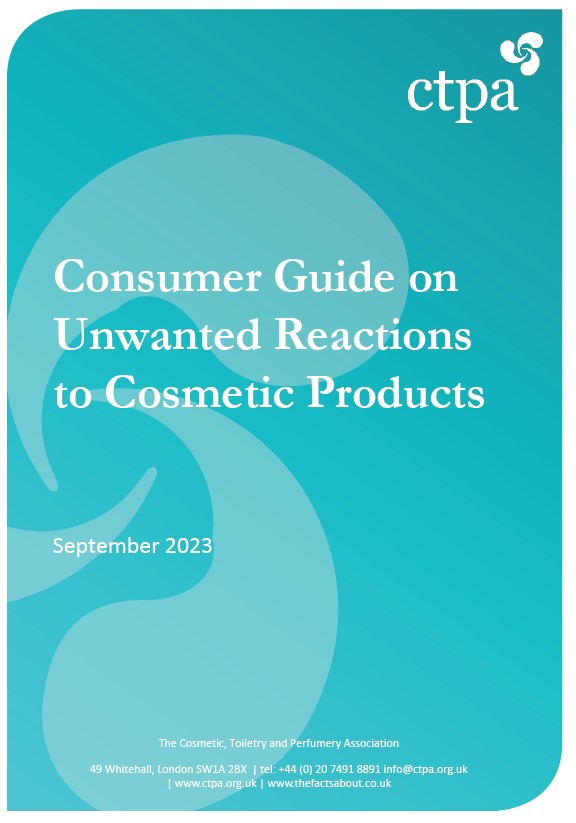 Manufacturers of cosmetic products want consumers to enjoy using their products. However companies want to know if someone has a reaction to their product. A guide has been produced to help explain what to do in such an instance and why it is important to inform the cosmetic product manufacturer, as well as an updated allergy factsheet.
Manufacturers of cosmetic products want consumers to enjoy using their products. However companies want to know if someone has a reaction to their product. A guide has been produced to help explain what to do in such an instance and why it is important to inform the cosmetic product manufacturer, as well as an updated allergy factsheet.
